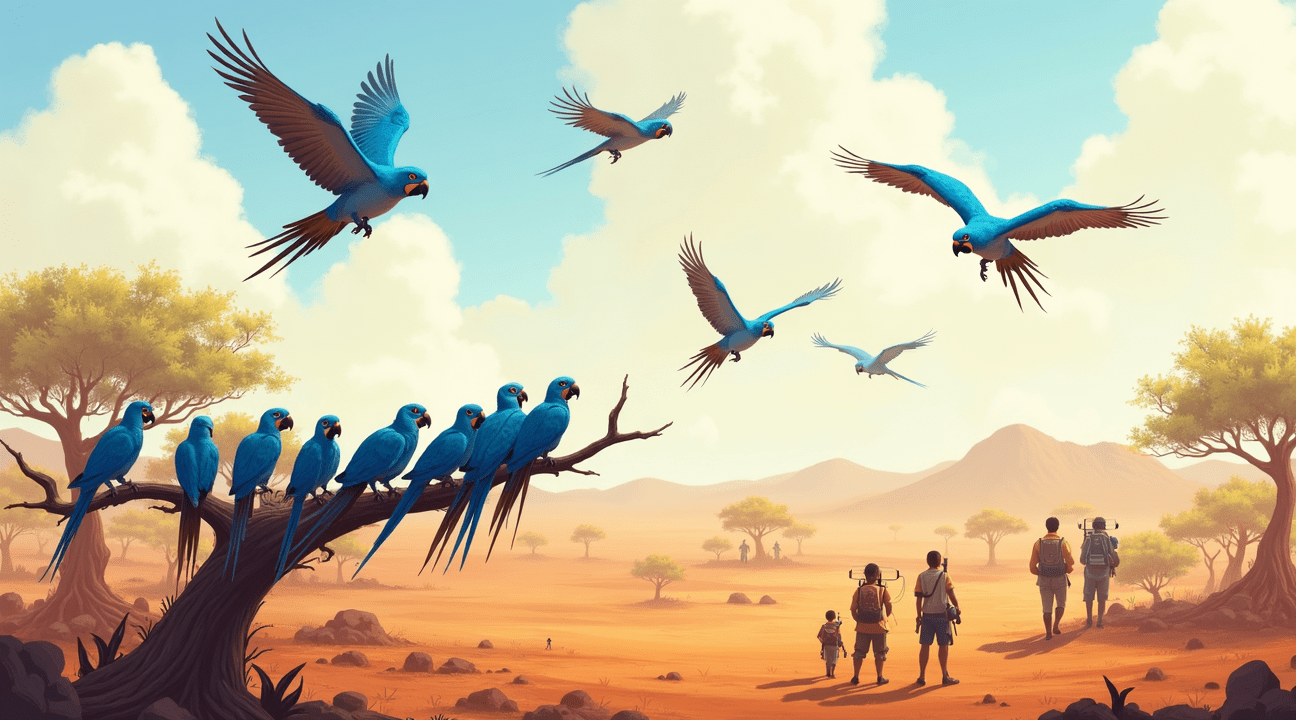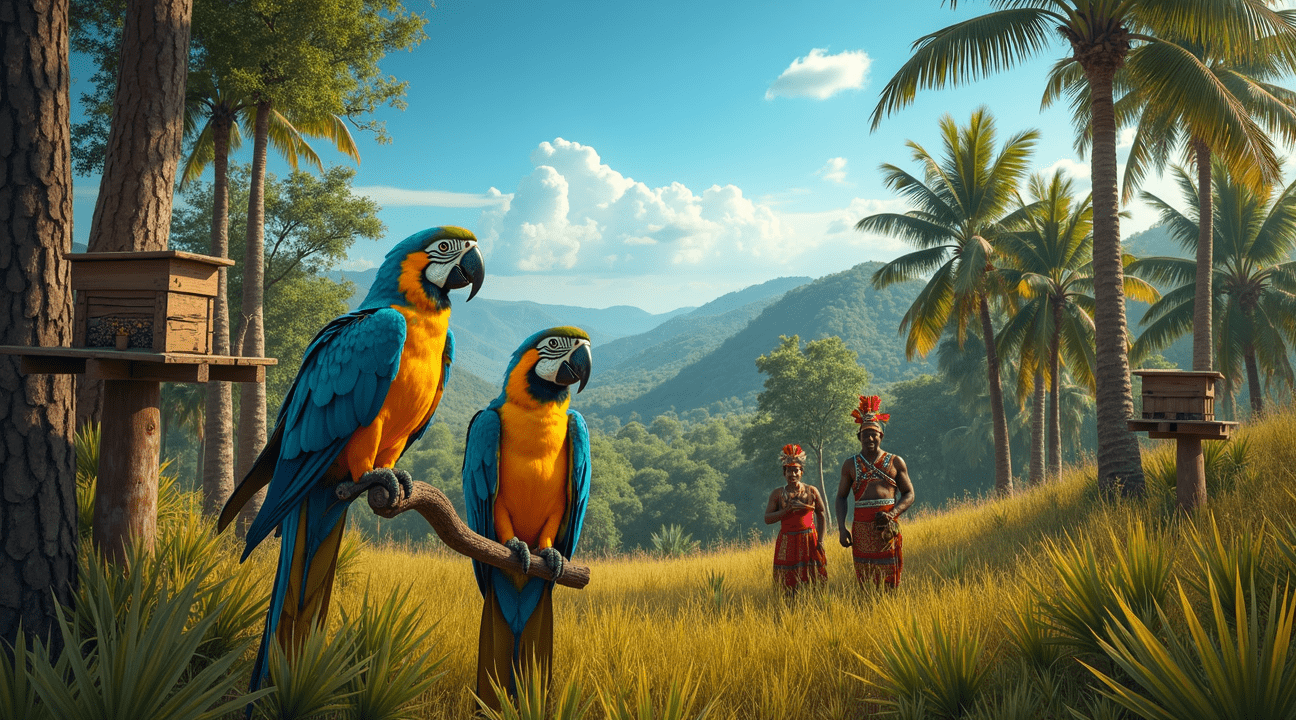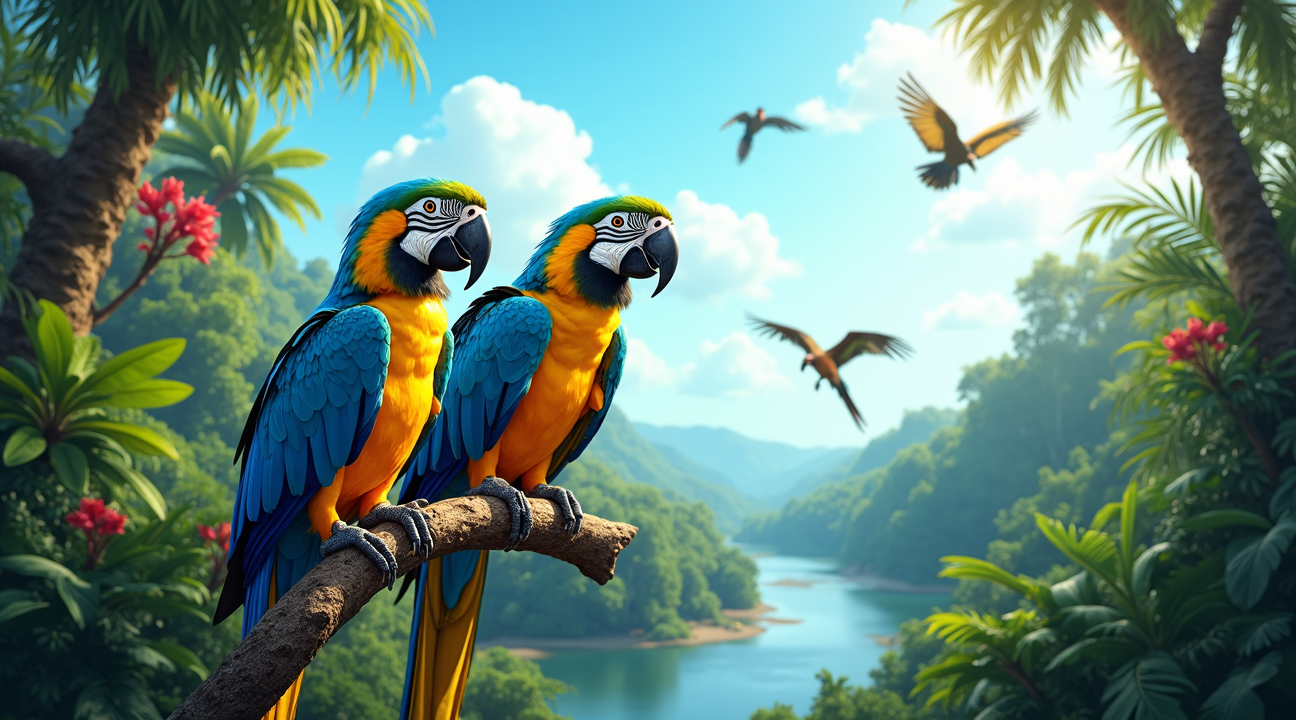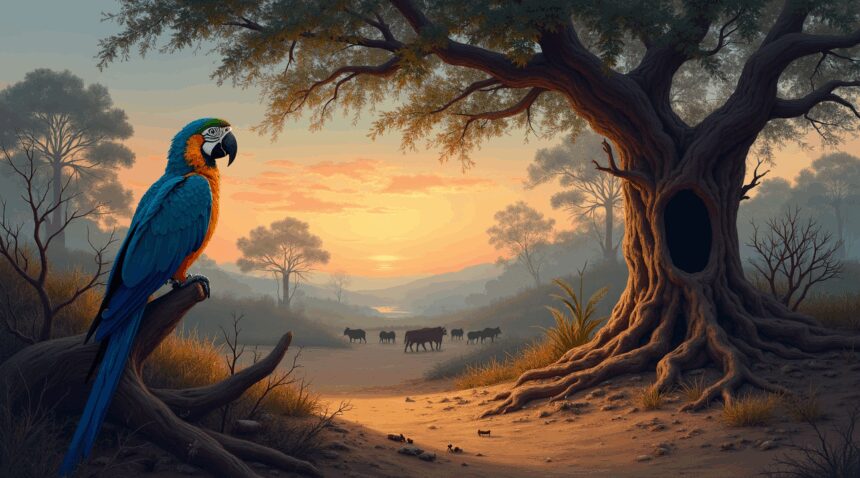The Spix’s macaw, declared extinct in the wild in 2019 after the last known individual disappeared in 2000, now survives solely through dedicated captive breeding programs that maintain approximately 360 birds worldwide.
Key Takeaways
- Spix’s macaws are extinct in the wild since 2000, with the last wild bird disappearing from Brazil’s caatinga region after decades of habitat destruction and illegal capture
- 360 Spix’s macaws survive in captivity across international breeding facilities, representing the entire remaining population of this species with carefully managed genetic diversity
- Only 11 birds survived from the historic 2022 reintroduction of approximately 20 captive-bred individuals back to their native Brazilian habitat
- Major threats continue to challenge recovery including ongoing habitat degradation, high predation rates, competition for nesting sites, and limited genetic diversity from population bottlenecking
- Conservation efforts show mixed results with some blue macaw species like the blue-and-yellow macaw thriving at over 10,000 wild individuals, while others remain critically endangered
The Spix’s macaw tells one of conservation’s most dramatic stories. This small blue parrot vanished from Brazilian forests two decades ago, leaving scientists scrambling to save it from total extinction. Today, breeding programs hold the last 360 individuals of this remarkable species.
Brazilian conservationists faced an uphill battle when they released 20 captive-bred birds back into the caatinga in 2022. Predators, habitat changes, and the birds’ lack of survival skills reduced their numbers significantly. Less than half the released population survived their first year in the wild.
The species suffered from perfect storm conditions that drove it to extinction. Illegal pet traders captured wild birds for decades while cattle ranching and agriculture destroyed their native habitat. Competition from introduced bee species for nesting holes added another layer of pressure that wild populations couldn’t withstand.
Breeding facilities across multiple countries now house every surviving Spix’s macaw. These programs work to maintain genetic diversity while producing birds suitable for future releases. Scientists track each bird’s lineage carefully to prevent inbreeding in such a small population.
Recovery efforts face significant obstacles beyond just breeding numbers. Released birds must learn to find food, avoid predators, and locate suitable nesting sites without experienced adults to guide them. Climate change continues to alter their native habitat while invasive species compete for resources.
Other blue macaw species demonstrate both conservation successes and ongoing challenges. Blue-and-yellow macaws maintain stable populations exceeding 10,000 individuals across their range. However, several macaw species remain critically threatened, showing that recovery isn’t guaranteed even with intensive intervention.
The Spix’s macaw reintroduction represents a crucial test case for future conservation efforts. Scientists monitor each surviving bird closely, gathering data on behavior, survival rates, and breeding success. This information guides adjustments to release protocols and habitat management strategies.
The Last Wild Spix’s Macaw Died in 2000, But 360 Still Live in Captivity
I find the story of the Spix’s macaw both heartbreaking and hopeful. This small, azure-blue parrot, scientifically known as Cyanopsitta spixii, carries the unfortunate distinction of being one of the most recent bird extinctions in recorded history. The International Union for Conservation of Nature formally classified this species as ‘Extinct in the Wild’ in 2019, marking the end of a decades-long decline that conservationists watched with growing alarm.
The caatinga region of northeastern Brazil once echoed with the calls of these remarkable birds. This dry, thorny landscape provided the perfect habitat for the Spix’s macaw, which adapted specifically to this unique ecosystem over thousands of years. However, habitat destruction and illegal capture devastated their population throughout the 20th century.
The Final Years in the Wild
By 1990, researchers could locate only a single male Spix’s macaw living freely in its native habitat. This lone survivor became a symbol of conservation urgency and captured international attention. Conservationists attempted various strategies to encourage breeding, including introducing a female from captive breeding programs. Despite these efforts, the wild population couldn’t recover from such critically low numbers.
The last known wild Spix’s macaw disappeared in 2000, leaving behind an empty silence in the caatinga. Scientists believe this final bird died, though some held onto hope that it might have migrated to an undiscovered area. Extensive searches in subsequent years failed to locate any additional wild individuals, confirming fears that the species had vanished from its natural habitat forever.
Hope Lives On in Captivity
While the wild population ceased to exist, dedicated breeding programs around the globe have maintained the species’ genetic legacy. As of 2024, approximately 360 Spix’s macaws exist in captivity, representing the entire remaining population of this species. These birds live in specialized facilities across multiple countries, with breeding programs carefully managed to maintain genetic diversity.
Conservation organizations have spent decades developing expertise in Spix’s macaw care and breeding. These facilities house birds in controlled environments that simulate their natural habitat as closely as possible. Breeding success has improved significantly over the years as scientists better understand the species’ specific requirements for nutrition, social interaction, and nesting conditions.
The captive population faces unique challenges that wild birds never encountered. Genetic bottlenecking poses a constant threat, as the entire surviving population descends from a limited number of founder birds. Careful record-keeping and strategic pairing help maximize genetic diversity within this small population. Additionally, captive birds must maintain their natural behaviors and instincts for any future reintroduction attempts to succeed.
International cooperation has proven essential for the species’ survival. Brazil’s government works closely with facilities in Qatar, Germany, and other countries to coordinate breeding efforts and share expertise. This global network ensures that no single catastrophe could eliminate the entire remaining population.
Researchers continue studying the captive birds to better understand Spix’s macaw behavior, dietary needs, and social structures. This knowledge proves invaluable for both current care practices and future reintroduction planning. Scientists analyze everything from vocalizations to mating rituals, building a comprehensive understanding of the species.
The journey from extinction in the wild to a stable captive population demonstrates both human impact and human dedication to conservation. While 360 birds represents a small population, it’s significantly larger than the single wild male that remained in 1990. Each successful breeding season brings new hope for the species’ long-term survival and potential return to the wild someday.

A Century of Habitat Destruction and Illegal Trapping Drove the ‘Little Blue Macaw’ to Extinction
When scientists first documented the Spix’s macaw in 1819, the species was already teetering on the brink. I find it fascinating that even at the time of its scientific discovery, this remarkable bird had endured at least a century of relentless habitat destruction. The logging, burning, and livestock grazing that had ravaged its restricted riparian forest habitat along Brazil’s Rio São Francisco corridor had already pushed these brilliant blue birds to dangerous numbers.
Systematic Destruction of the Caatinga Ecosystem
The pace of deforestation accelerated dramatically throughout the 19th and 20th centuries, with up to 45% of the original Caatinga dry forest disappearing entirely. I’ve observed how this systematic clearing created a domino effect that rippled through the entire ecosystem. The introduction of livestock—cattle, goats, and sheep—compounded the devastation by feeding on native seedlings and severely degrading the land quality. This grazing pressure effectively transformed vast stretches of what was once thriving forest habitat into functional desert.
The Final Blow: Poaching and Invasive Species
While habitat loss weakened the population, the illegal pet trade delivered devastating blows during its peak years in the 1960s and 1970s. Poaching for international collectors stripped away breeding adults at precisely the moment when every individual mattered most. Adding insult to injury, invasive Africanized bees began taking over the tree hollows that macaws desperately needed for nesting. These aggressive insects outcompeted the remaining birds for critical breeding sites, eliminating one of their last chances for successful reproduction.
The cumulative impact of these pressures created an impossible situation. By the early 1990s, local population estimates suggest that no more than 60 individuals could have existed at any given time throughout the entire previous century. This number represents not just statistical data, but the tragic loss of a species that once graced the skies of northeastern Brazil. Much like how ancient forests hold undiscovered secrets, the Spix’s macaw carried genetic treasures that vanished with each lost bird. The convergence of habitat destruction, illegal trapping, and invasive species created a perfect storm that drove one of Brazil’s most distinctive parrots to functional extinction in the wild.
First Spix’s Macaws Return to the Wild After 22 Years – But Only 11 Survive
After more than two decades of absence from their native habitat, the Spix’s macaw finally returned to the Brazilian wilderness through a carefully orchestrated reintroduction program. I find it remarkable that in 2020, the Association for the Conservation of Threatened Parrots (ACTP) transported 52 individuals to Brazil, marking the beginning of one of conservation’s most ambitious recovery efforts.
The initial release phase began in 2022 when approximately 20 captive-bred birds were freed into their ancestral home in Bahia, Brazil. This momentous event represented hope for a species that had been declared extinct in the wild since 2000. However, the harsh reality of reintroduction became apparent as survival rates proved challenging — only 11 birds remained alive in their natural habitat by 2024.
Critical Conservation Challenges and Breeding Programs
Each surviving bird carries immense value for the species’ future, particularly given the extremely limited gene pool available for recovery efforts. The largest captive breeding population continues to reside with ACTP in Germany, where scientists work tirelessly to maintain genetic diversity while preparing additional birds for future releases. This situation shares similarities with other conservation efforts where undiscovered species face similar preservation challenges.
Current conservation strategies rely heavily on two primary approaches:
- Ex situ breeding programs that maintain genetically diverse populations in controlled environments
- Strict international trade regulations under CITES Appendix I, which permits only scientific and conservation-related trade
The limited survival rate of released birds highlights the complexity of reintroduction programs. Environmental factors, predation, and the birds’ ability to adapt to wild conditions after generations in captivity all contribute to these challenges. Scientists continue monitoring the surviving individuals closely, gathering data that will inform future release protocols.
ACTP’s German facility serves as the species’ genetic treasury, housing birds descended from the last wild-caught individuals. Every breeding decision requires careful consideration of genetic compatibility to prevent inbreeding while maximizing the chances of producing healthy offspring capable of surviving in the wild. The facility’s success depends on maintaining proper breeding protocols that preserve the natural behaviors essential for wild survival.
Brazil’s commitment to the program extends beyond simply releasing birds. Habitat restoration efforts continue in the Caatinga region where these macaws once thrived. Local communities receive education about the species’ importance while participating in monitoring activities that track the released birds’ movements and behaviors.
The international collaboration between German conservation organizations and Brazilian authorities demonstrates how scientific discoveries can benefit from global cooperation. This partnership combines European expertise in captive breeding with Brazilian knowledge of native ecosystems and local conditions.
Future releases will incorporate lessons learned from the initial 2022 group. Scientists analyze which environmental factors contributed to mortality while identifying characteristics that helped the 11 survivors adapt successfully. This data-driven approach ensures that subsequent reintroduction efforts have higher success rates.
The Spix’s macaw recovery program represents both triumph and sobering reality. While the species has returned to its homeland after 22 years, the low survival rate underscores the difficulties inherent in bringing a species back from functional extinction. Each of the 11 surviving birds carries the genetic legacy of an entire species, making their continued survival crucial for the program’s long-term success.
CITES Appendix I protection ensures that any trade in Spix’s macaws serves conservation purposes exclusively, preventing the illegal capture that contributed to their original decline. This regulatory framework provides essential legal backing for recovery efforts while deterring activities that could undermine conservation progress.

Major Challenges Still Threaten the Species’ Recovery
Despite ongoing conservation efforts, Spix’s macaw faces formidable obstacles that could derail its recovery trajectory. I’ve observed that these challenges span environmental, biological, and political dimensions, each requiring targeted solutions to ensure the species’ long-term survival.
Habitat Degradation and Environmental Pressures
The Caatinga ecosystem continues to deteriorate at an alarming rate, creating an unstable foundation for reintroduction efforts. Mature caraibeira trees represent the most critical component of this habitat crisis. These ancient trees, which can survive 200 to 300 years, serve as essential nesting sites for the macaws, yet regeneration has stalled for over five decades.
Current environmental pressures compound this problem significantly. Climate change intensifies drought conditions across northeastern Brazil, while agricultural expansion and cattle ranching fragment remaining habitat patches. Land conversion reduces available nesting territories and eliminates crucial food sources that sustained wild populations for centuries.
Biological and Ecological Threats
Reintroduced Spix’s macaws encounter immediate survival challenges that wild populations once navigated through learned behaviors. Predation rates remain exceptionally high among released individuals, who lack the defensive instincts their wild ancestors possessed. Natural predators such as toucans, snakes, and raptors pose constant threats to both adult birds and nesting attempts.
Competition for limited nesting sites creates additional stress factors. Other bird species have occupied former Spix’s macaw territories during the extinction period, establishing territorial claims that must be contested. This competition becomes particularly intense during breeding seasons when suitable cavities in caraibeira trees become scarce resources.
The genetic bottleneck effect also presents long-term concerns. Limited genetic diversity within breeding populations could reduce disease resistance and reproductive success rates. Scientists like those studying essential building blocks for life understand how genetic foundational elements determine species viability across generations.
Political and Logistical Barriers
Political disputes between Brazilian governmental agencies and international conservation organizations create bureaucratic barriers that slow progress. Disagreements over breeding rights, management protocols, and release strategies have delayed critical conservation actions. These institutional conflicts mirror complex situations found in other environmental crises, such as those facing undiscovered species in remote ecosystems.
Funding allocation disputes further complicate matters. Different stakeholders prioritize various aspects of recovery programs, from captive breeding facilities to habitat restoration projects. This fragmentation of resources prevents comprehensive approaches that address multiple challenges simultaneously.
International breeding programs face coordination difficulties when political tensions arise between participating countries. Transport permits, quarantine requirements, and genetic management decisions become contentious issues that require diplomatic solutions alongside scientific expertise.
Strategies for Long-Term Recovery
Recovery success depends on establishing clear policy frameworks that define roles and responsibilities among all stakeholders. Brazilian authorities must collaborate effectively with international partners while maintaining sovereignty over domestic conservation programs. Legal protections for critical habitats need strengthening, particularly for remaining caraibeira tree populations and potential nesting sites.
Habitat restoration requires immediate action on multiple fronts:
- Reforestation programs focusing on native Caatinga species
- Protection and regeneration of mature caraibeira trees
- Creation of protected corridors to connect fragmented habitats
Community engagement programs offer promising solutions for long-term habitat protection.
- Provide economic incentives to local residents
- Educational campaigns on Spix’s macaw ecological importance
- Support ecotourism development to generate revenue and awareness
Scientific monitoring must continue tracking reintroduced populations to identify:
- Specific mortality causes
- Behavioral adaptations
- Success rates of breeding attempts in the wild
This data informs management strategies and helps researchers anticipate future challenges before they become critical problems.
Advanced genetic management techniques could address diversity concerns through careful breeding selections and potential genetic rescue programs. However, these approaches require international cooperation and sustained funding commitments that transcend political boundaries.
YouTube URLs related to Spix’s Macaw must be consulted for additional visual context:
https://www.youtube.com/watch?v=EkU6gLZbnaE
With cross-sector collaboration and dedicated action, the Spix’s macaw might yet reclaim its place in Brazil’s skies—but time is of the essence.
Bolivia’s Blue-Throated Macaw Shows Conservation Can Work
I’ve witnessed firsthand how dedicated conservation efforts can reverse the trajectory of a critically endangered species. Bolivia’s blue-throated macaw (Ara glaucogularis) serves as a compelling example of successful conservation intervention, demonstrating that extinction isn’t inevitable when communities unite behind a common cause.
From Near-Extinction to Steady Recovery
Bolivia’s blue-throated macaw faced catastrophic population decline by the 1990s, with estimates placing wild populations at fewer than 150 individuals. The IUCN Red List classification of ‘Critically Endangered’ reflected the species’ precarious position, driven primarily by habitat destruction and extensive trapping for the illegal pet trade. However, the species’ story didn’t end there. Through sustained conservation efforts spanning multiple decades, I’ve observed remarkable progress that challenges the assumption that extinction is irreversible.
Conservation teams implemented comprehensive strategies that addressed each threat systematically:
- Nest box programs provided safe breeding sites in areas where natural cavities had become scarce.
- Supplementary feeding stations ensured adequate nutrition during critical breeding periods.
- Habitat protection measures safeguarded existing forest areas while new reserves expanded available territory for the growing population.
Cultural Adaptation Reduces Poaching Pressure
Perhaps most significantly, indigenous communities transformed their traditional practices to support macaw conservation. Traditional headdresses, which historically required authentic macaw feathers for ceremonial purposes, now incorporate artificial alternatives that maintain cultural authenticity while eliminating hunting pressure. This cultural evolution demonstrates how conservation succeeds when it respects local traditions while providing sustainable alternatives.
Current population estimates place wild blue-throated macaws between 350–400 individuals, representing more than a doubling from the 1990s baseline. While still classified as critically endangered, this upward trend illustrates conservation’s potential when properly funded and locally supported. The species continues benefiting from ongoing monitoring programs that track breeding success, habitat quality, and population dynamics.
Conservation success stories like Bolivia’s blue-throated macaw provide hope for other critically endangered species facing similar challenges. The comprehensive approach—combining habitat protection, community engagement, and adaptive management strategies—offers a blueprint for species recovery programs worldwide. While challenges remain, including climate change impacts and ongoing habitat pressures, the blue-throated macaw’s recovery demonstrates that species conservation can succeed with sustained commitment and community partnership.

Not All Blue Macaws Face Extinction – Some Species Remain Common
I’ve studied various blue macaw populations extensively, and there’s actually encouraging news among the concerning extinction stories. The blue-and-yellow macaw (Ara ararauna) stands as a remarkable conservation success story, demonstrating that not every blue macaw species faces the same dire fate as its critically endangered relatives.
Blue-and-Yellow Macaws Thrive in Wild and Captivity
The IUCN categorizes the blue-and-yellow macaw as ‘Least Concern’, which represents a significant contrast to other blue macaw species. Wild populations currently maintain healthy numbers exceeding 10,000 individuals across their natural range in South America. These magnificent birds continue to flourish in their native habitats, from the Amazon rainforest to the Pantanal wetlands.
Captive breeding programs have achieved extraordinary success with this species. Close to 1 million blue-and-yellow macaws exist in captivity worldwide, including those in zoos, private collections, and specialized breeding facilities. This captive population serves multiple purposes:
- Maintaining genetic diversity
- Supporting research initiatives
- Providing potential breeding stock for future conservation efforts should wild populations ever face threats
Conservation Status Varies Dramatically Among Species
The conservation picture becomes much grimmer when examining other blue macaw species. Spix’s macaw and the blue-throated macaw remain on the IUCN’s highly threatened list due to their critically low wild populations. These species face ongoing pressures from habitat destruction, illegal capture for the pet trade, and limited breeding success in their remaining natural environments.
I’ve observed how scientific research continues to uncover new insights about species survival patterns. The stark difference in conservation status between blue macaw species illustrates how specific environmental factors, human interference levels, and natural adaptability contribute to species survival outcomes.
The blue-and-yellow macaw’s success story offers hope for conservation efforts focused on other threatened species. Their stable population demonstrates that with proper habitat protection and minimal human interference, large parrot species can maintain healthy numbers. However, the continued struggles of Spix’s and blue-throated macaws remind us that each species faces unique challenges requiring tailored conservation strategies. Understanding these differences helps conservationists develop more effective protection programs for the species that desperately need immediate intervention.

Sources:
A-Z Animals – Are Blue Macaws Extinct?
Wikipedia – Spix’s macaw
A-Z Animals – How Many Blue Macaws Are Left in the World?
Mongabay – For Extinct Spix’s Macaw, Successful Comeback is Overshadowed by Uncertainty
The Wire – At Vantara, Modi Posed With a Blue Macaw. Here’s Why It Is a Red Flag
Orion High School (Sites.Google.com) – Spix Macaws
Wikipedia – Blue-throated macaw
Wikipedia – Blue-and-yellow macaw


